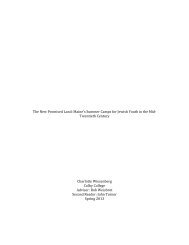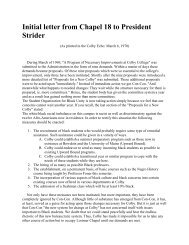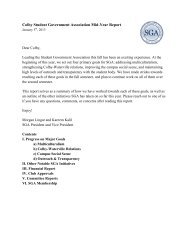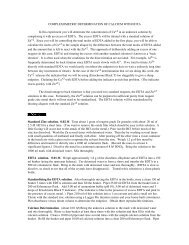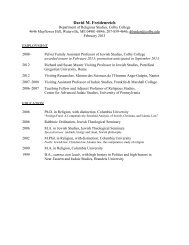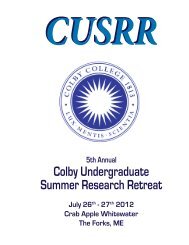College Attendance Among Jews in Lewiston, Maine, During the ...
College Attendance Among Jews in Lewiston, Maine, During the ...
College Attendance Among Jews in Lewiston, Maine, During the ...
You also want an ePaper? Increase the reach of your titles
YUMPU automatically turns print PDFs into web optimized ePapers that Google loves.
college. For example, Libby Goldman, from Auburn, recounted that she and her bro<strong>the</strong>rs each<br />
saved 10 cents a week grow<strong>in</strong>g up for <strong>the</strong> purpose of pay<strong>in</strong>g for college. Then, s<strong>in</strong>ce her fa<strong>the</strong>r<br />
did not have much money, her bro<strong>the</strong>rs decided to give her <strong>the</strong>ir sav<strong>in</strong>gs so that she could go to<br />
Bates because she was <strong>the</strong> smartest child (Goldman 2010). This is surpris<strong>in</strong>g: one might th<strong>in</strong>k<br />
that it would have been her fa<strong>the</strong>r that paid for her education. It is also evident that her family<br />
had little economic means because she received f<strong>in</strong>ancial aid. And like many of <strong>the</strong> Ma<strong>in</strong>e’s<br />
Jewish students who attended college <strong>in</strong>-state, Libby lived at home and commuted because her<br />
family could not afford room and board.<br />
Lester Jolovitz, who grew up <strong>in</strong> W<strong>in</strong>slow and graduated from Colby <strong>in</strong> 1939, reflects on<br />
his family’s f<strong>in</strong>ancial background:<br />
I th<strong>in</strong>k my first semester was $300. And I was able to live at home. My fa<strong>the</strong>r<br />
was, you know, a simple grocer, had one store, we had three or four people<br />
work<strong>in</strong>g <strong>in</strong> <strong>the</strong> store, but my fa<strong>the</strong>r made what we would call a sort of comfortable<br />
liv<strong>in</strong>g compared with <strong>the</strong> people that were our customers, because all of our<br />
customers were mill workers, and, you know, <strong>in</strong> those days a mill worker would<br />
make $25, $30 a week, and raise a family… my fa<strong>the</strong>r was <strong>in</strong> bus<strong>in</strong>ess and we<br />
were <strong>Jews</strong>, so we were always considered wealthy. (Jolovitz 2010)<br />
Figure 8 <strong>in</strong>dicates that <strong>Lewiston</strong>’s <strong>Jews</strong> were better off than <strong>the</strong> average <strong>Lewiston</strong><br />
residents, but as Goldman and Jolovitz describe, many <strong>Jews</strong> <strong>in</strong> Ma<strong>in</strong>e still lived humble lives. Аs<br />
Jolovitz implies, we must remember to abandon our baggage of Jewish stereotypes: <strong>the</strong> Jewish<br />
students <strong>in</strong> this study were not children of doctors and lawyers. If <strong>the</strong>y were, <strong>the</strong>se statistics<br />
would not be surpris<strong>in</strong>g. These students had immigrant parents who were shop owners and<br />
merchants. They were from middle class families. They lived more comfortably than <strong>the</strong><br />
majority of <strong>the</strong> town, and <strong>the</strong>ir college attendance rates demonstrate elite values, but <strong>the</strong>y were<br />
not <strong>the</strong> elite.<br />
10



